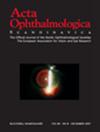The polarity effect of direct current stimulation on the vascular regulation of the inner retina
Abstract
Aims/Purpose: Electrical stimulation is not only a suitable method for researching the human nervous system but also for treating neuronal disorders. In ophthalmology, it is applied to patients suffering from various retinal diseases like retinitis pigmentosa. It is known that in the application of direct current stimulation (DCS), the polarity of the current determines the increase or decrease in neuronal activity and enables different therapeutic approaches. However, the polarisation-dependent effect of the current on the vascular processes in the retina has not yet been investigated. This study examined the effect of anodal and cathodal DCS on the temporal vessels of the inner retina.
Methods: The study was conducted on 24 healthy subjects (14w, 10m, mean age 25.5 ± 3.2yr) who were randomly assigned to either an anodal or a cathodal DCS group (symmetrical design). To test the effect of the DCS (800μA; ring-shaped electrode placed surrounding the eye, square electrode placed at the occiput) on vascular regulation, the DCS was combined with visual flicker stimulation using the Dynamic Vessel Analyzer (DVA, Imedos Systems GmbH; standard protocol). Exclusion criteria were ocular and systemic diseases. We investigated two primary vessel segments (superior temporal artery (STa) and vein (STv)) located between 0.5 and 2.0 disc diameters from the optic disc. For each subject the DVA was performed two times (first baseline DVA1, followed by a 20-minute DCS (different polarity depending on the group), and directly afterwards a second DVA2). For statistical analysis, the t-test for paired samples was used and Bonferroni corrected.
Results: The mean vascular responses (STa/STv) for the anodal DCS group were DVA1: 3.7 ± 1.7%/3.4 ± 1.6%; DVA2: 3.5 ± 1.3%/5.4 ± 3.2% and for the cathodal DCS group DVA1: 3.2 ± 2.0%/4.0 ± 2.6%; DVA2: 3.2 ± 1.4%/2.5 ± 1.3%. For the venous vascular response, we found a significant increase after anodal DCS (p = 0.019) and a significant decrease after cathodal DCS (p = 0.018).
Conclusions: We were able to successfully determine the effect of different DCS polarities on the retinal vascular system. We found significant effects on the veins. The absence of effects on the arteries indicates different regulatory pathways in the retina. This should be investigated by further selective stimulation.

 求助内容:
求助内容: 应助结果提醒方式:
应助结果提醒方式:


